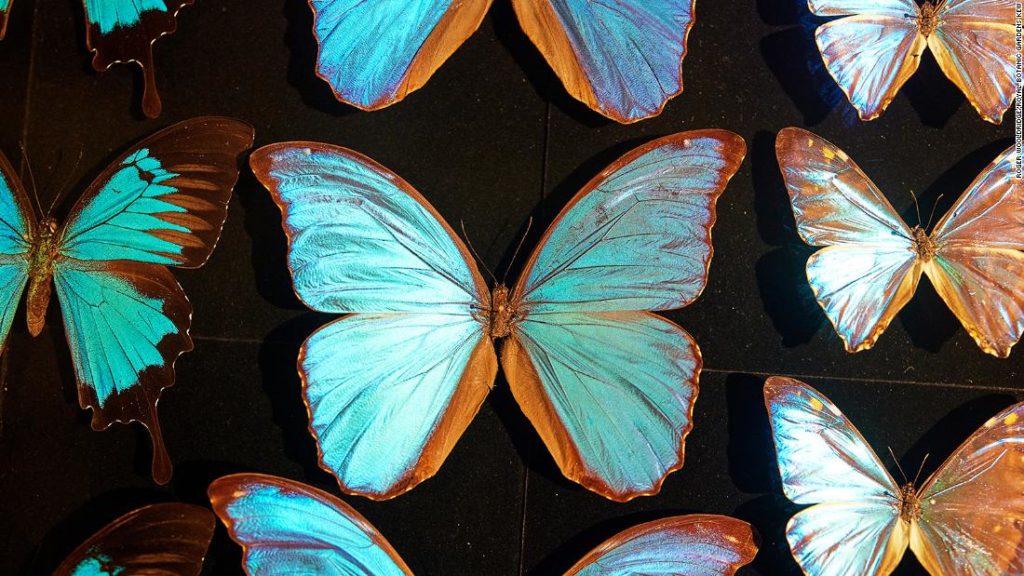Art and science can seem two opposites on a spectrum. One is creative and interpretive, the other exact and empirical. But an emerging technology known as Pure Structural Colour — dubbed the “boldest, brightest color on Earth” in a new exhibition — shows how interplay between the two may be revolutionary for both.
The gallery itself is dark, with black walls accentuating expressionist paintings by Parker himself. Some were inspired by sunlight and phenomena like the Big Bang, while others imitate the colors and textures of flower petals and butterfly wings.

A kaleidoscopic artwork titled “Composition of Sunlight” by Lifescaped’s Andrew Parker. Credit: Lifescaped
Elsewhere, panels bearing different hues of Pure Structural Colour “shine like jewels,” according to Paul Denton, head of visitor programs and exhibitions at Kew Gardens. Also on display is a painting by artist Coral G. Guest, who used the technology to recreate the metallic sheen of pollia berries. There are examples of possible commercial applications, too, from a pair of Nike sneakers to sunglasses and watches.
Art imitates life
Parker’s fascination with the colors found in nature began while studying marine organisms in Australia in the 1990s. “If we look at the tiniest of coral reef creatures under the microscope, we can see the most incredible colors, much brighter than pigments,” he said in a phone interview. “And when you look at them under electron microscopes you can see the minute structures that interact with light to produce these colors.”
The vivid hues of living creatures are often structural; they are produced by microscopic cell structures that can interact with light to create dazzling optic effects. Typically, artists rely on intricate combinations of pigments to portray the world around them, but using Pure Structural Colour may make it easier to reproducing a variety of color wavelengths, Parker said.

An artwork inspired by the patterns and colors of nature. Credit: Roger Wooldridge/Royal Botanic Gardens Kew
“Color is entirely formed in the mind. There are only waves of electromagnetic radiation passing all around us, and we convert that to color,” Parker said. “Art and science are really brought together by color. Here we’re using physics in order to manipulate and refine the nuances of color we can produce.”
One of the ways that Lifescaped has developed Pure Structural Colour is in the form of tiny transparent flakes. These can be mixed with a biodegradable polymer and paint formulations to produce various visual effects, such as intensely bright colors, iridescent colors that seem to change when viewed at different angles, and colors that seamlessly blends into one another.
Seeing green
In addition to drawing inspiration from the natural world, Pure Structural Colour invites awareness of the environment in another way altogether: It is less harmful to the planet than most dyes and pigments, according to Parker.
Commercially available acrylics and oil paint are made up of tiny pigments. To ensure they can spread evenly on a given surface, manufacturers add chemical solvents, resins and other additives that aid the drying process, Parker said.

Lifescaped is developing a series of products using its Pure Structural Colour technology. Credit: Lifescaped
In contrast, flakes of Pure Structural Colour naturally diffuse and assemble evenly on surfaces, and thus don’t require additional chemicals, according to Parker. Lifescaped’s colors are often produced using silicon dioxide, a biodegradable compound found organically in nature.
Parker said the environmental implications of the technology are, potentially, game-changing. As well as reducing reliance on toxic polluting paints, the nanostructures’ ability to form an extremely thin continuous surface could help reduce carbon emissions.

Panels of Pure Structural Colour that imitate the shades of butterfly wings on display at London’s Royal Botanic Gardens, Kew. Credit: Roger Wooldridge/Royal Botanic Gardens Kew
“The paint itself is lightweight, so it lends itself well to commercial products,” he said. “For example, if you replace the paints used to cover a jumbo jet with a structural color, you would be saving about one ton in weight, which is quite significant for fuel costs.”
While Pure Structural Colour is not yet commercially available, the Lifescaped lab is working with various companies to manufacture paints for sale, and hopes to have some available “within the next 12 months,” Parker said.
Parker’s mission stretches beyond the technology’s commercial potential, however. The scientist and artist said he wants visitors to leave the exhibition thinking more critically about the power of nature and how much humans can learn from it.
“Nature is of such value, and we need to do more to protect it,” Parker said. “There are so many other things we can learn by looking to nature. With a bit more effort we can come up with a lot more sustainable solutions in the future.”
You may also like
-
Afghanistan: Civilian casualties hit record high amid US withdrawal, UN says
-
How Taiwan is trying to defend against a cyber ‘World War III’
-
Pandemic travel news this week: Quarantine escapes and airplane disguises
-
Why would anyone trust Brexit Britain again?
-
Black fungus: A second crisis is killing survivors of India’s worst Covid wave

